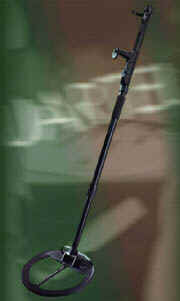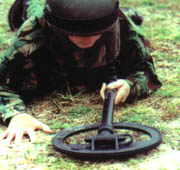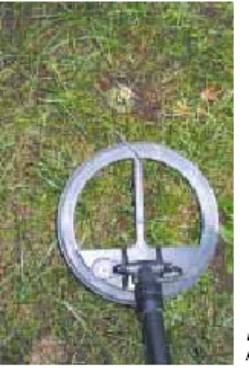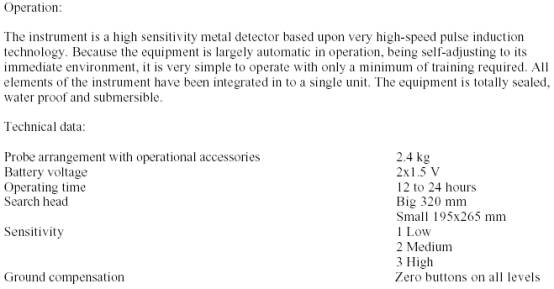



The new MD8 Mine and Metal Detector was designed for use by the British Army and is also now in use with UK Police Forces for search operations. The instrument is a high sensitivity metal detector based upon very high speed pulse induction technology and has exceptional performance against minimum metal mines. Because the equipment is largely automatic in operation, being self adjusting to its immediate environment, it is very simple to operate with only a minimum of training required.
All elements of the instrument (with the exception of an optional external earphone) have been integrated into a single unit incorporating a control unit, batteries and telescopic halo assembly. There are no separate parts, and consequently no cumbersome interconnecting cables. The equipment is totally sealed, waterproof and submersible.The instrument is controlled by a microprocessor, which permits very precise timing, rapid switching and sophisticated signal processing. This, in conjunction with the novel head design, permits detection of very small metallic objects even in the proximity of larger targets. Incorporated are comprehensive and automatic self-diagnostic procedures controlled by the microprocessor. A user initiated test facility is also present. The verification of these tests is presented to the operator by a confidence tone.
The search head incorporates differential Rx coils which greatly reduce interference from external sources so enhancing the signal/noise ratio and permitting greater sensitivity. This feature also allows objects outside the area of the halo to be disregarded. However, the area of desensitisation is controlled so that signals from the sides of the search head are accepted. The use of differential coils greatly enhances the ability of the equipment to operate in traditionally hostile conditions, for example over mineralised soils, without loss of sensitivity.The halo is divided fore and aft by a 'sighting bar'. When the centre of the target is directly below this bar a very distinct null appears in the audio signal thus permitting the location of the centre of the target to within a few millimetres.
The MD8 electronics incorporate an automatic power supply that enables the detector to be powered by only two dry-cells. The power supply maintains a constant voltage to the electronics, permitting maximum performance, whatever the state of the batteries, and utilises the full capacity of the cells.
Power
Requirements:
Batteries:
2 x 'D' drycells IEE LR20. Manganese alkaline
Life: Max sensitivity - 12 hours continuous, 16 hours intermittent Med/Low
sensitivity -18
hours continuous, 24 hours Intermittent
Low Battery: Indicated by two stage flashing LED and audio tone
Control unit (incorporating batteries):
Length: 470 mm
Weight: 1100 g inc. batteries
Microprocessor: 2 x RISC based 8 BIT incorporating ADC
Transit
Case:
Weight: 7 kg
Transit Weight: 10 kg
Operating Weight: 2.4 kg
Length: 740 x 400 x 20 mm
Operating Length: Max. 1560 mm, Min. 1120 mm
Max. useable detection: 0.05 g stainless steel at 75 mm
Temperature: -25°C to +70°C (operation and storage)
Environmental: Humidity - fully sealed and submersible to 2 metres
Halo Probe:
Max.
Length: 1120 mm
Min. Length: 700 mm
Weight: 100 g
NATO STOCK NO:
NSN 6665-99-727-8434
